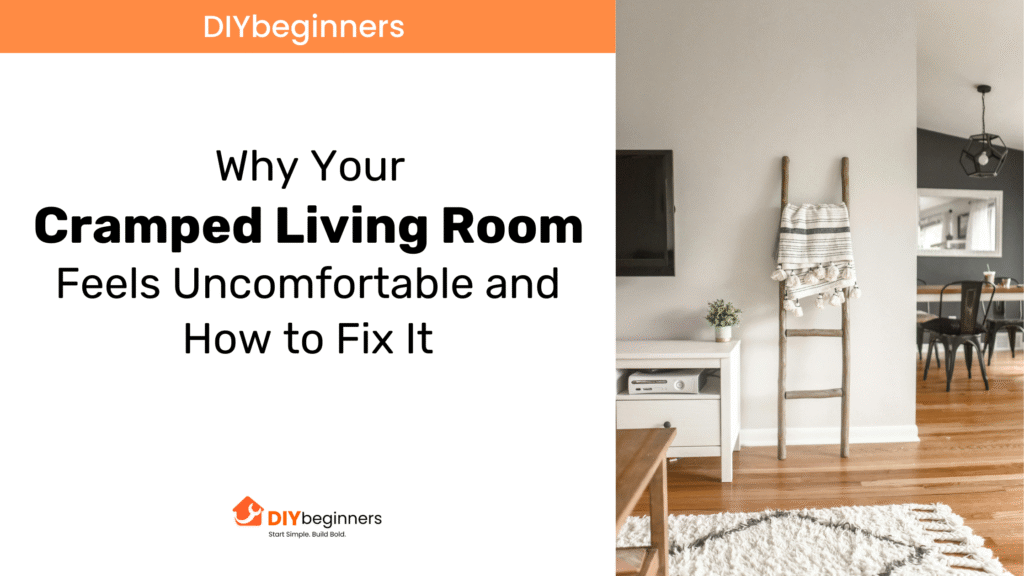
Entering your living room should not be an adventurous mission, but a lot of people end up having to maneuver their way in and out of the furniture and get stuck in their own house. Knowing why your stuffy living room is so claustrophobic to you is the first step in getting a more roomy interior. The positive news? Defines the boundary between wisdom and the answer to the riddle of the spirit?TONR Even a congested living room does not have to remain so when a proper design method is applied. Most inhabitants believe that their limited living room is too small, but the actual problem usually consists of inefficient layout decisions, excessive furniture size, and the failure to take advantage of both aesthetic and formal spaces.
The Real Reasons Your Living Room Feels Cramped
1. Architectural Challenges Working Against You
The bones of your room may be fighting you already, before you get started. Unconventional shapes of rooms and structural elements may interfere with the circulation, so even relatively small spaces may appear cramped and uncomfortable. In cases where your living room is possessed by awkward angles, protruding columns,, an oddly located doorway, these all form visual disturbances that divide the room.
The lack of many pathways to walk on because of the terrible positioning of furniture produces the intrinsic feeling of a maze to walk in, contributing to the small size of the room. Most homeowners, without realizing it, make it difficult to accommodate natural movement by arranging all the furniture to adjoin the walls or by clumping the peripheries of furniture that cause people to pick their way around the furniture. The absence of designated zones alspreconditionson the disalignment of space destination in it, when all areas have several functions without strict demarcations.
2. Furniture Scale Problems That Shrink Your Space
The number one offender of a cramped living room is usually at the tips of your toes. Furniture over-scaled can cause a room to feel stuffy in an instant. Research indicates that the perfect sofa measurement is somewhere between 84-90 inches in most living rooms; however, a majority of individuals end up purchasing sofa sets that are way too big, as they loved it when they saw it in the furniture store.
Too much furniture makes the place visually and physically cluttered, even when the furniture has been arranged neatly. The coffee table must be at least a third of the length of the sofa in order to have proportions. When such measurements are inaccurate, the room comes off as being uneven and crammed despite having the square footage.
Small Living Room Ideas That Actually Work
1. Strategic Furniture Arrangement Solutions
These living room small ideas can make even the smallest of spaces practical and comfortable. The trick here is in making focal points clear in order to put order into your layout. Rather than trying to get everything up against walls, pull furniture out into the room so there is more close grouping. This defying logic not only creates larger perceptions of rooms by delineating conversation space and enhancing traffic patterns in rooms.
Creating specific traffic routes is important in the enhancement of movement in your space. Easy living room design can really transform how open your room will be when you emphasize the flow of traffic rather than the placement of additional chairs. Note how traffic flows through your room and place furniture to encourage these patterns and not interfere with them.
2. Multi-Functional Furniture Magic
The best small living room ideas consider smart use of furniture to maximize visual/physical space. Shelves and bookcases are built-in, which maximizes vertical space without taking up any floor space. Multi-purposefully functional furniture items can be used on two occasions, examples include an ottoman with secret storage or a coffee table that turns into a dining one.
Modular displays and the use of baskets are strategic and can help to create a decent yet well-organized storage that does not portray clutter. These living room designs are ideal in apartments and smaller houses where space does not allow wastage. When many of the pieces have multi-purpose use, you can achieve the same amount of comfort and functionality with an assortment of fewer pieces.
Narrow Living Room Ideas for Better Flow
1. Working With Your Room’s Natural Shape
You can play up the contrast between spaces, so make narrow living room ideas centered around the idea of creating a wide space by positioning items carefully instead of struggling against the proportions of your room. The best narrow living room ideas incorporate the actual shape of a room and do not fight it. Rather than lining furniture up the long walls, place furniture in the center to create more than one zone.
Think of designing conversation spaces that are aligned along a direction, and that are across the length of the room. This also interrupts the bowling alley effect; It makes narrow rooms feel cramped and awkward. Narrow living room layout concepts are most effective once you use the proportions of the room to your advantage, dividing it into functional zones with plenty of breathing room.
2. Visual Tricks That Add Width
Light colors reflect light (natural as well as artificial) effectively, which makes cramped areas feel lighter and airier. One-colored palettes will make your visuals more unified and non-disruptive to the look of your space. Decor accents in the form of colors that accent the decor will add character without overpowering the room.
Mirror position acts to fool the eye into perceiving the enlargement of space through the reflection of light as well as views. Hang windows above position mirrors to cast natural light around the space, or place windows opposite position mirrors to make a room look bigger and to reflect a scenic view. Vertical lines on the wall cause attention to focus further up to give the impression of height, and this helps challenge the feeling of narrowness.
Design Principles That Open Up Your Space
1. Color and Light Strategies
The meaning of a cramped living room extends beyond the translations of physical size to the emotional size and the feel of a room and its functionality. The floors and walls are light colored to give the rooms a feeling of a much larger space than they actually are. Just because it is a white kitchen does not mean that everything should be white; soft, light blues and greens, and warm neutral colors can all provide the same feeling of spaciousness with added personality.
Through the use of window coverings, maximize natural sunlight, where individual privacy is not compromised, but instead daylight is allowed in. Use sheering curtains, light-blocking blinds,s, or shutters to permit some light in, but still have privacy. Artificial light should add ambient, task, and accent light to add dimension and remove dark spaces, which makes a room feel smaller.
2. Proportion and Balance Techniques
Ensure that functionality is prioritized in all the layouts and directions, and that balance and proportion are maintained in selecting furniture. Each piece must possess a functional and, therefore, visual advantage to a space. Add partitions between different activities without the use of solid walls by using furniture pieces, lighting, and area rugs to create specific spaces.
Rounded furniture over straight lines is currently a trend that can create a smaller space that seems soft and flows better. The movement towards natural materials in a small space design will bring a sense of warmth and additional texture without cluttering the small space. Brighter colors are re-emerging in place of more conventional neutral palettes, but in a small room, they must be used sparingly and only as accents.
Transform Your Cramped Living Room Today
Your living room is not supposed to be the source of your day-to-day frustrations, but rather a comfort and relaxation area. By treating the causes of cramped feelings, you can achieve a room that feels much larger and functional, instead of the culprits: furniture scale problems, to ineffective traffic flow. The solutions will not require a significant remodeling or vast funds to refurbish everything; in most cases, a few rearrangements and strategic decisions will go a long way.
Focus on one part in the beginning and slowly make these changes in your space. It is important to recognize that physical space is only part of the picture of making your room feel broader. It is also about designing an environment that requires a room that can support the way you actually move and live in your home. These guidelines should make your congested living room the most relaxing place you desire.
